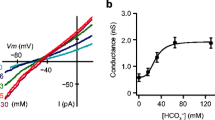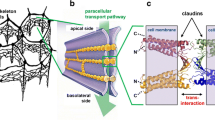Summary
Electrophysiologic and tracer experiments have shown that Cl− entersNecturus proximal tubule cells from the tubule lumen by a process coupled to the flow of Na+, and that Cl− entry is electrically silent. The mechanism of Cl− exit from the cell across the basolateral membrane has not been directly studied. To evaluate the importance of the movement of Cl− ions across the basolateral membrane, the relative conductance of Cl− to K+ was determined by a new method. Single-barrel ion-selective microelectrodes were used to measure intracellular Cl− and K+ as a function of basolateral membrane PD as it varied normally from tubule to tubule. Basolateral membrane Cl− conductance was about 10% of K+ conductance by this method. A second approach was to voltage clamp the basolateral PD to 20 mV above and below the spontaneous PD, while sensing intracellular Cl− activity with the second barrel of a double-barrel microelectrode. An axial wire electrode in the tubule lumen was used to pass current across the tubular wall and thereby vary the basolateral membrane PD. Cell Cl− activity was virtually unaffected by the PD changes. We conclude that Cl− leavesNecturus proximal tubule cells by a neutral mechanism, possibly coupled to the efflux of Na+ or K+.
Similar content being viewed by others
References
Anagnostopoulos, T. 1973. Biionic potentials in the proximal tubule ofNecturus kidney.J. Physiol. (London) 233(2):375
Anagnostopoulos, T., Planelles, G. 1979. Organic anion permeation at the proximal tubule ofNecturus.Pfluegers Arch. 381:231
Anagnostopoulos, T., Velu, E. 1974. Electrical resistance of cell membranes inNecturus kidney.Pfluegers Arch. 346:327
Boulpaep, E.L. 1967. Ion permeability of the peritubular and luminal membrane of the renal tubular cell.In: Transport und Funktion Intracellulärer Electrolyte. F. Krück, editor, pp. 98–107. Urban & Schwarzenberg, Munich
Boulpaep, E.L. 1976a. Electrical phenomena in the nephron.Kidney Int. 9:88
Boulpaep, E.L. 1976b. Recent advances in electrophysiology of the nephron.Annu. Rev. Physiol. 38:20
Giebisch, G. 1961. Measurements of electrical potential differences on single nephrons of the perfusedNecturus kidney.J. Gen. Physiol. 44:659
Khuri, R.N., Agulian, S., Bogharian, K., Aklanjian, D. 1975. Electrochemical potentials of chloride in proximal renal tubule ofNecturus maculosus.Comp. Biochem. Physiol. 50A:695
Khuri, R.N., Hajjar, J.J., Agulian, S., Bogharian, K., Kalloghlian, A., Bizri, H. 1972. Intracellular potassium in cells of the proximal tubule ofNecturus maculosis.Pfluegers Arch. 338:73
Kimura, G., Spring, K.R. 1978. Transcellular and paracellular trace chloride fluxes inNecturus proximal tubule.Am. J. Physiol. 235(6):F617 orAm. J. Physiol.: Renal Fluid Electrolyte Physiol.4(6):F617
Kimura, G., Spring, K.R. 1979. Luminal Na+ entry intoNecturus proximal tubule cells.Am. J. Physiol. 236(3):F295 orAm. J. Physiol: Renal Fluid Electrolyte Physiol.5(3):F295
Kimura, G., Spring, K.R. 1980. Ionic conductance of the cell membranes and shunts ofNecturus proximal tubule.Curr. Topics Membr. Transp. 13:265
Ogden, T.E., Citron, M.C., Pierantoni, R. 1978. The jetstream microbeveller: An inexpensive way to bevel ultrafine glass micropipettes.Science. 201:469
Reuss, L. 1979. Electrical properties of the cellular transepithelial pathway inNecturus gallbladder. III. Ionic permeability of the basolateral cell membrane.J. Membrane Biol. 47:239
Reuss, L., Weinman, S.A. 1979. Intracellular ionic activities and transmembrane electrochemical potential differences in gall-bladder epithelium.J. Membrane Biol. 49:345
Spring, K.R., Giebisch, G. 1977. Tracer Na fluxes inNecturus proximal tubule.Am. J. Physiol. 232:F461 orAm. J. Physiol.: Renal Fluid.Electrolyte Physiol. 1:F461
Spring, K.R., Kimura, G. 1978. Chloride reabsorption by renal proximal tubules ofNecturus.J. Membrane Biol. 38:233
Spring, K.R., Paganelli, C.V. 1972. Sodium flux inNecturus proximal tubule under voltage clamp.J. Gen. Physiol. 60:181
Whittembury, G., Diezi, F., Diezi, J., Spring, K., Giebisch, G. 1975. Some aspects of proximal tubular sodium chloride reabsorption inNecturus kidney.Kidney Int. 7:293
Windhager, E.E., Boulpaep, E.L., Giebisch, G. 1966. Electrophysiological studies on single nephrons.Proc. Int. Congr. Nephrol. (3rd, Washington, D.C.)1:35
Author information
Authors and Affiliations
Rights and permissions
About this article
Cite this article
Shindo, T., Spring, K.R. Chloride movement across the basolateral membrane of proximal tubule cells. J. Membrain Biol. 58, 35–42 (1981). https://doi.org/10.1007/BF01871032
Received:
Revised:
Issue Date:
DOI: https://doi.org/10.1007/BF01871032




